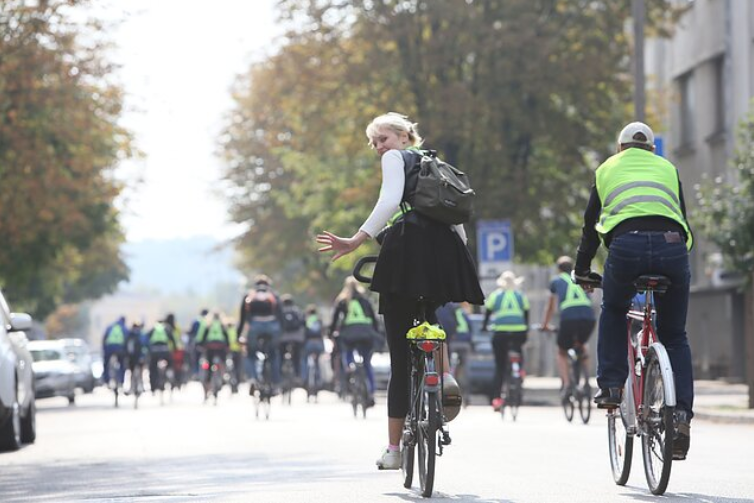Lithuanian cycling enthusiasts have been striving for change for some time now – they would like to ride through pedestrian crossings without getting off the bike and change the order when it is necessary to wear reflective vests or ride with the lights on. It is on the latter issue that the Seimas will decide in the autumn.
In early July, the government assessed the desire of cyclists to allow them to ride through pedestrian crossings without getting off their bikes. According to LRT.lt, then the Government decided to keep the current procedure – cyclists are not allowed to ride through pedestrian crossings without getting off the bicycles unless it is a regulated crossing or road markings indicate that the road is crossed by a bicycle path.
However, the proposal on the use of brightly colored vests and lanterns has been submitted to the Seimas for consideration.
Under current regulations, cyclists must wear brightly colored vests or ride with their lights on at all times, regardless of the time of day or where they ride – in the city or on the highway, on a bike path or the roadside.
The draft submitted to the Seimas envisages changing this procedure. It is proposed that wearing a brightly colored vest and driving with the lights on should only be mandatory during the dark hours of the day when cycling in the city or on the street, as well as on the highway and that the vests or headlights should only be worn during the day.
Will decide in the fall
A special working group headed by MP Tom Tomlin was convened in the Seimas to resolve the issue of cyclists and prepare a draft law.
He assures that the draft law seeks to find a compromise that would satisfy both cyclists and other road users, although some categorically opposed the changes.
“The Ministry of Transport was quite categorically against it, although at first, it seemed to be prone to consideration. I understand the arguments that any solution that affects road safety is debatable, but I think that a certain level of human comfort is also very important for cycling culture. They feel that there is too much flying in their lifestyle and clothing,” says T. Tomilinas.
Vidmantas Pumputis, the head of the Traffic Safety Department of the Ministry of Transport and Communications, who was interviewed on the LRT RADIO program “Morning Sounds”, has noticed that the currently valid requirements did not come about by accident.
“A few years ago, the visibility of cyclists was a very big problem, especially in cities, where many tragic events took place.
Until the city has developed infrastructure suitable for cyclists, there are no consistently designed bicycle paths (for example, in Vilnius from Justiniškės, Fabijoniškės or Šeškinė it is practically impossible to drive to the central part of the city without getting on the road), it is necessary to do everything to make the cyclist visible,” said V. Pump.
He added that cyclists are given two alternatives. This is to wear a brightly colored vest or another bright garment with reflective elements or to mount headlights on the front and back of the bike. It is these tools that help to better notice the cyclist.
The head of the Seimas working group emphasizes that in resolving this issue, efforts were made to take into account the wishes of cyclists as one of the groups of road users, as certain changes may encourage people to ride bicycles more often than cars.
“I think the problem is that we are too car-oriented. In our country, the vast majority of the population is driving. Attempts are being made to protect their comfort and safety, but cyclists are also a traffic group that cares about their safety. They just don’t want to be overworked with that worry,” says T. Tomilinas.
True, speaking about the amendment to the law prepared by a working group convened in the Seimas, T. Tomilinas states that it is still too early to decide whether the amendments will be adopted or not. This decision will finally be clear in autumn.
“As with all laws, in this case, submission, deliberation, and adoption are awaited. Members of the Seimas will register this proposal and it will be discussed in the autumn. It usually takes 2-3 months.
If the law is approved, I think it would be logical if it came into force on the first of January next year, “T. Tomilinas explains.

